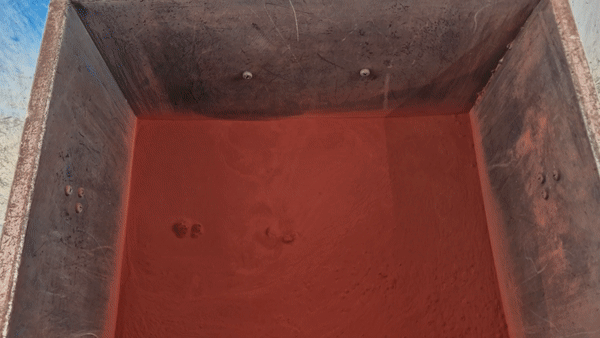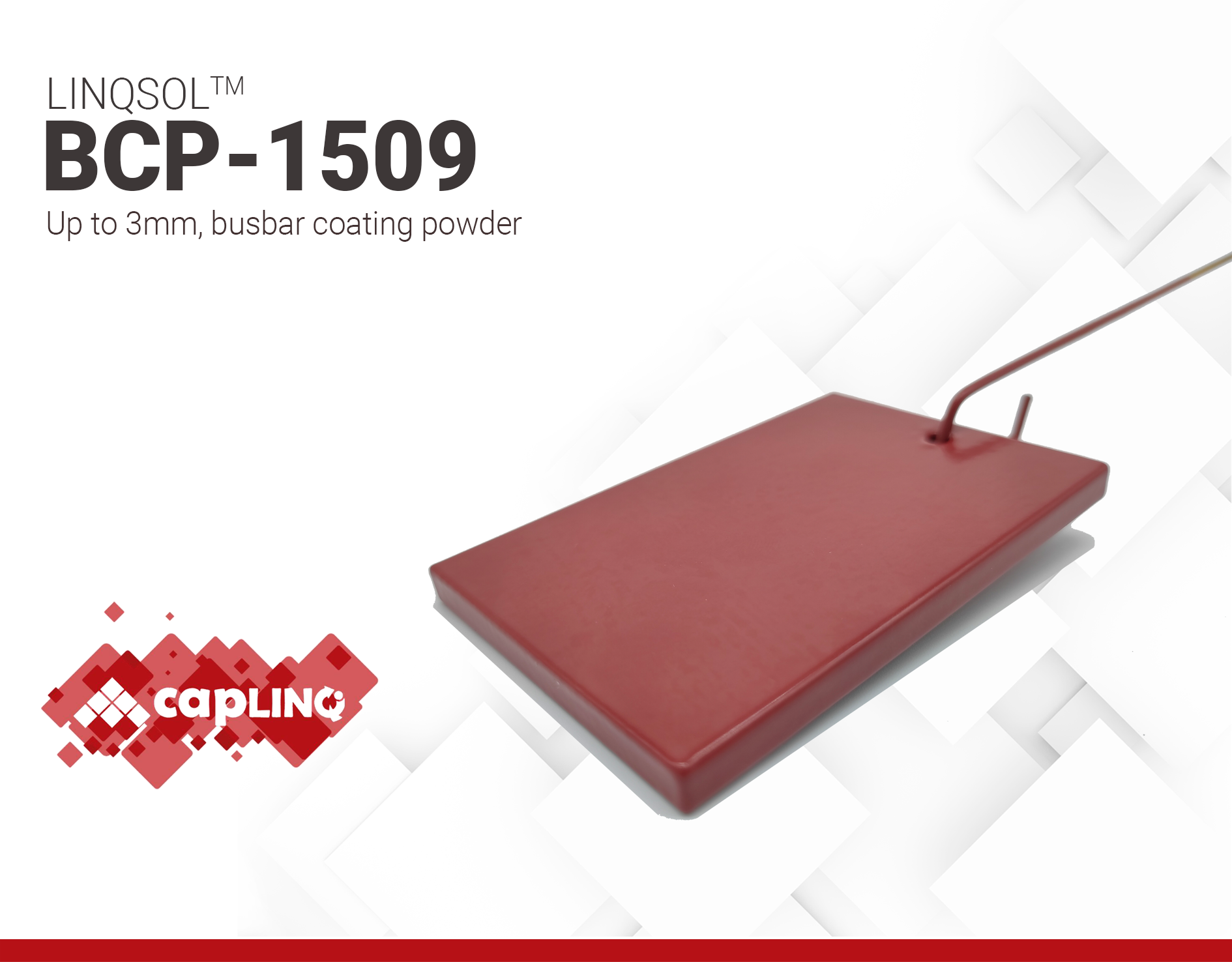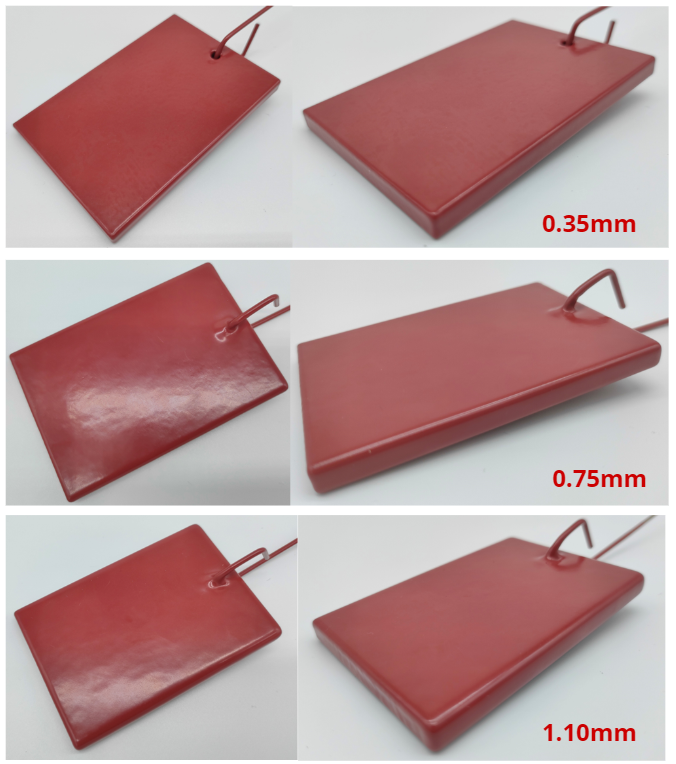BCP-1509 | Medium voltage Busbar Coating Powder
- Reddish Brown Color
- Up to 3mm thickness
- RTI Class B
Product Description
LINQSOL BCP-1509 is a Reddish brown, busbar epoxy coating powder. It aims at medium to high voltage busbar applications. It performs uniform and smooth coating results from 0.3mm to 3mm.
It is especially suitable for large busbar applications used for power distribution. With optimized gel time and flow, it allows large busbars with high heat capacity dip multiple times in fluidized bed to build thickness as high as 3mm without dripping and sag. BCP-1509 meets the UL 746B Relative Thermal Index (RTI) of 130°C and CTI 600V. For small busbar applications, we recommend BCP-1507 with powder quick build rate.
Features:
- Aims at medium to high voltage application
- Comparable with DK19
- Good adhesion to copper, alumina
- Thick and no-sag coating performance
- Both electrostatic spray and fluidized bed coating
Recommended coating Temperature:
- 180 – 230 °C. (200 °C x 30 min)
Technical Specifications
| General Properties | |||||
| Color Color The color | Reddish Brown | ||||
| Process Method | Fluidized bed, electrostatic spray | ||||
| Specific Gravity Specific Gravity Specific gravity (SG) is the ratio of the density of a substance to the density of a reference substance; equivalently, it is the ratio of the mass of a substance to the mass of a reference substance for the same given volume. For liquids, the reference substance is almost always water (1), while for gases, it is air (1.18) at room temperature. Specific gravity is unitless. | 1.5 | ||||
| |||||
| Electrical Properties | |||||
| Breakdown Voltage Breakdown Voltage Breakdown voltage is the minimum voltage necessary to force an insulator to conduct some amount of electricity. It is the point at which a material ceases to be an insulator and becomes a resistor that conducts electricity at some proportion of the total current. After dielectric breakdown, the material may or may not behave as an insulator any more because of the molecular structure alteration. The current flow tend to create a localised puncture that totally alters the dielectric properties of the material. This electrical property is thickness dependent and is the maximum amount of voltage that a dielectric material can withstand before breaking down. The breakdown voltage is calculated by multiplying the dielectric strength of the material times the thickness of the film. | 35 V | ||||
| Volume Resistivity Volume Resistivity Volume resistivity, also called volume resistance, bulk resistance or bulk resistivity is a thickness dependent measurement of the resistivity of a material perpendicular to the plane of the surface. | 1.0x10-13 Ohms⋅cm | ||||
| Mechanical Properties | |||||
| Edge Coverage | 45 % | ||||
| Impact Strength | 500 mm | ||||
| Thermal Properties | |||||
| |||||
| Glass Plate Flow Glass Plate Flow Glass plate flow determines the flow distance of thermosetting epoxies, resins or coating powders on a smooth inclined glass surface in a certain time and temperature. This value is the distance in millimetres from the upper point of the original position of the pellet to the point of extreme flow. Typically measured at 150°C but please check the TDS for more info | 18 mm | ||||
| UL 94 Rating UL 94 Rating Flammability rating classification. It determines how fast a material burns or extinguishes once it is ignited. HB: slow burning on a horizontal specimen; burning rate less than 76 mm/min for thickness less than 3 mm or burning stops before 100 mm V-2: burning stops within 30 seconds on a vertical specimen; drips of flaming particles are allowed. V-1: burning stops within 30 seconds on a vertical specimen; drips of particles allowed as long as they are not inflamed. V-0: burning stops within 10 seconds on a vertical specimen; drips of particles allowed as long as they are not inflamed. 5VB: burning stops within 60 seconds on a vertical specimen; no drips allowed; plaque specimens may develop a hole. 5VA: burning stops within 60 seconds on a vertical specimen; no drips allowed; plaque specimens may not develop a hole | V-0 | ||||
| Other Properties | |||||
| RoHS Compliant RoHS Compliant RoHS is a product level compliance based on a European Union Directive which restricts the Use of certain Hazardous Substances in Electrical and Electronic Equipment (RoHS). Products compliant with this directive do not exceed the allowable amounts of the following restricted materials: lead, mercury, cadmium, hexavalent chromium, polybrominated biphenyls (PBB) and polybrominated diphenyl ethers (PBDE), with some limited exemptions | YES | ||||
Additional Information

Storage
Store in a ventilated, dry, and clean environment below 25°C. Keep away from fire and heat sources. It is strictly forbidden to store in outdoor environments. At proper storage conditions, the product has a shelf life of 6 months.
Precautions
- Avoid long-term skin contact. Powder that touched the skin should be rinsed off quickly.
- During operation dust-proof masks should be used to avoid inhalation.
- Keep the oven temperature stable, so as not to affect the colour and quality of the coating due to excessive temperature deviation.
- The concentration of dust should be controlled within a safe range to avoid malfunction of the coating equipment.
Linqsol Busbar Coating Products Selection Guide
| BCP-1000 | BCP-1504 | BCP-1507 | BCP-1509 | |
| Specific Gravity, g/cc | 1.45±0.05 | 1.52±0.05 | 1.50 | 1.50 |
| Glass Plate Flow | 18-22mm@150°C, 45° | 10-22mm@150°C, 60° | 19-20 mm@180°C | 19-20 mm@180°C |
| Hot Plate Gel Time | 70 sec@150°C | 45±15 sec@160°C | 60 sec@180°C | 60 sec@180°C |
| Edge Coverage, % | 45 | 45 | 45 | 45 |
| Hardness, shore D | >80 | >90 | - | - |
| Impact Resistance, cm | >50 | >50 | >50 | >50 |
| Dielectric Strength (kV/mm) | >42 | >35 | >35 | >35 |
| Flammability, UL94 | V-0 | V-0 | V-0 | V-0 |
| Min. Coating Thickness | 0.3mm | 0.3mm | 0.1mm | 0.3mm |
| Max. Coating Thickness | 1mm | 1mm | 2mm | 3mm |
| Electrostatic Spray | ■■■ | ■□□ | ■■■ | ■■■ |
| Dip Coating | ■□□ | ■■■ | ■■■ | ■■■ |
| Available Color | ●●●●● | ●● | ●●●●● | ● |
| Preheat Temperature | 180~240 °C | 150~180 °C | 180~230 °C | 180~230 °C |
| Curing Conditions | 200°C x 15min | 200°C x 15min | 200°C x 30min | 200°C x 30min |




